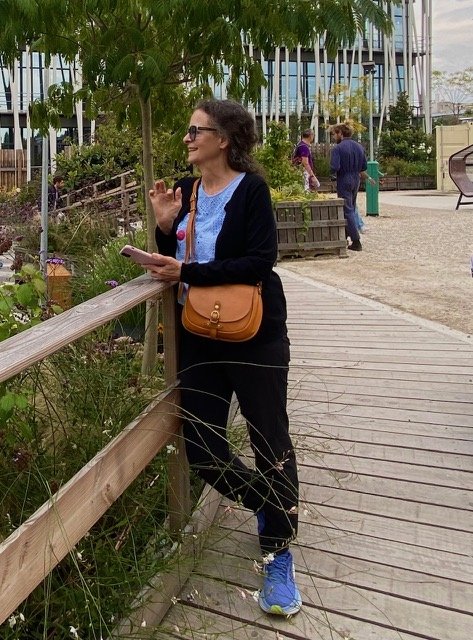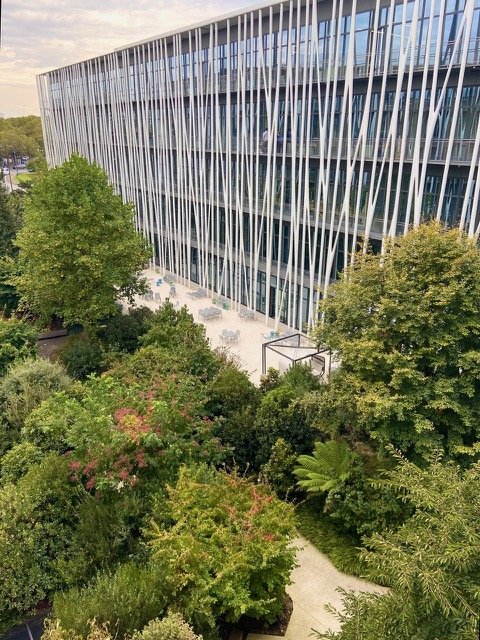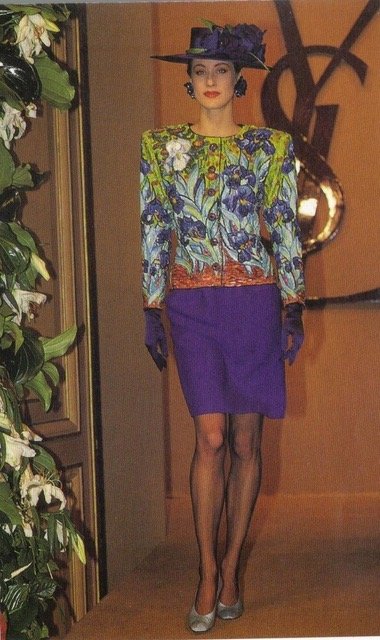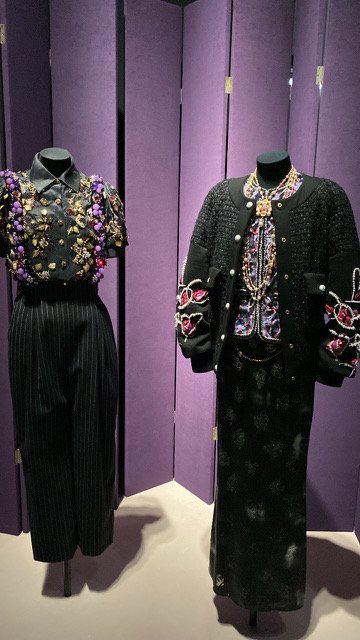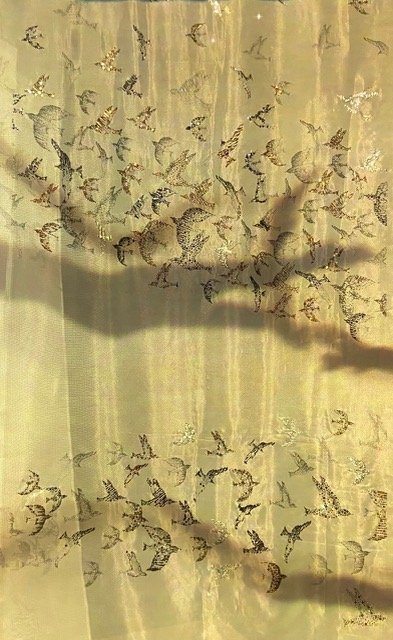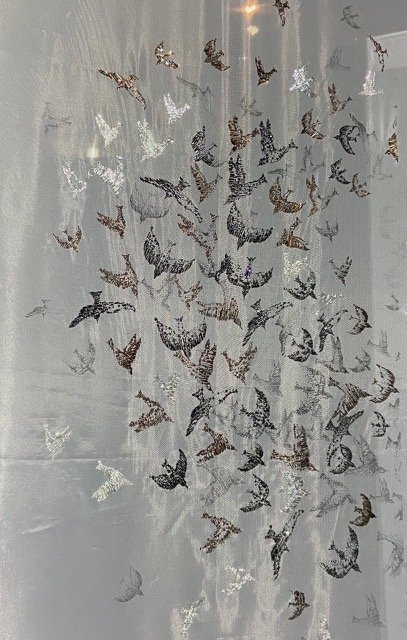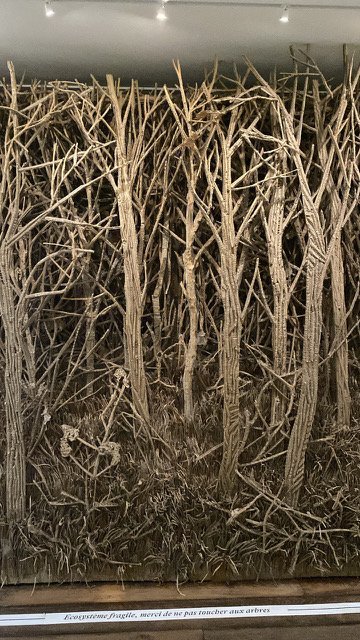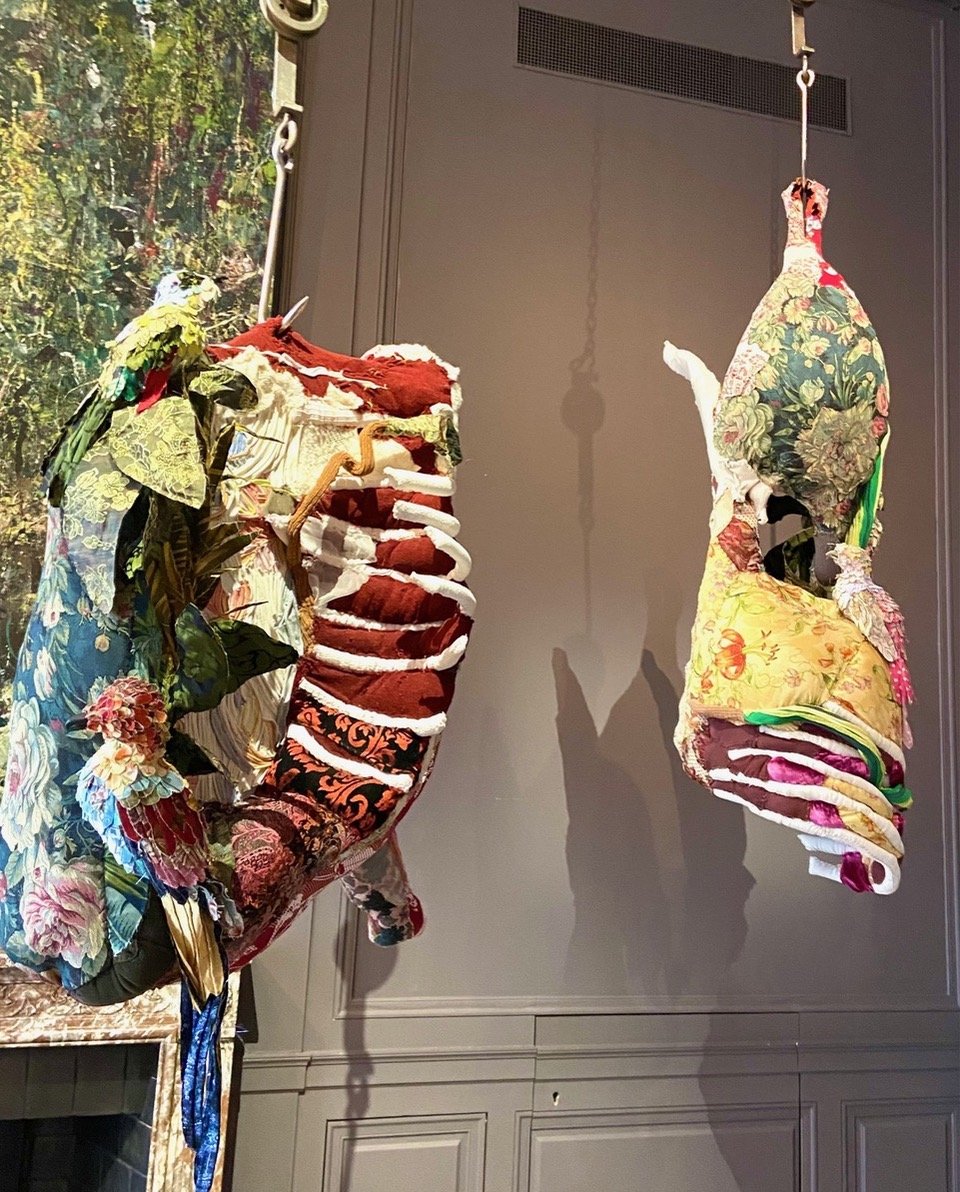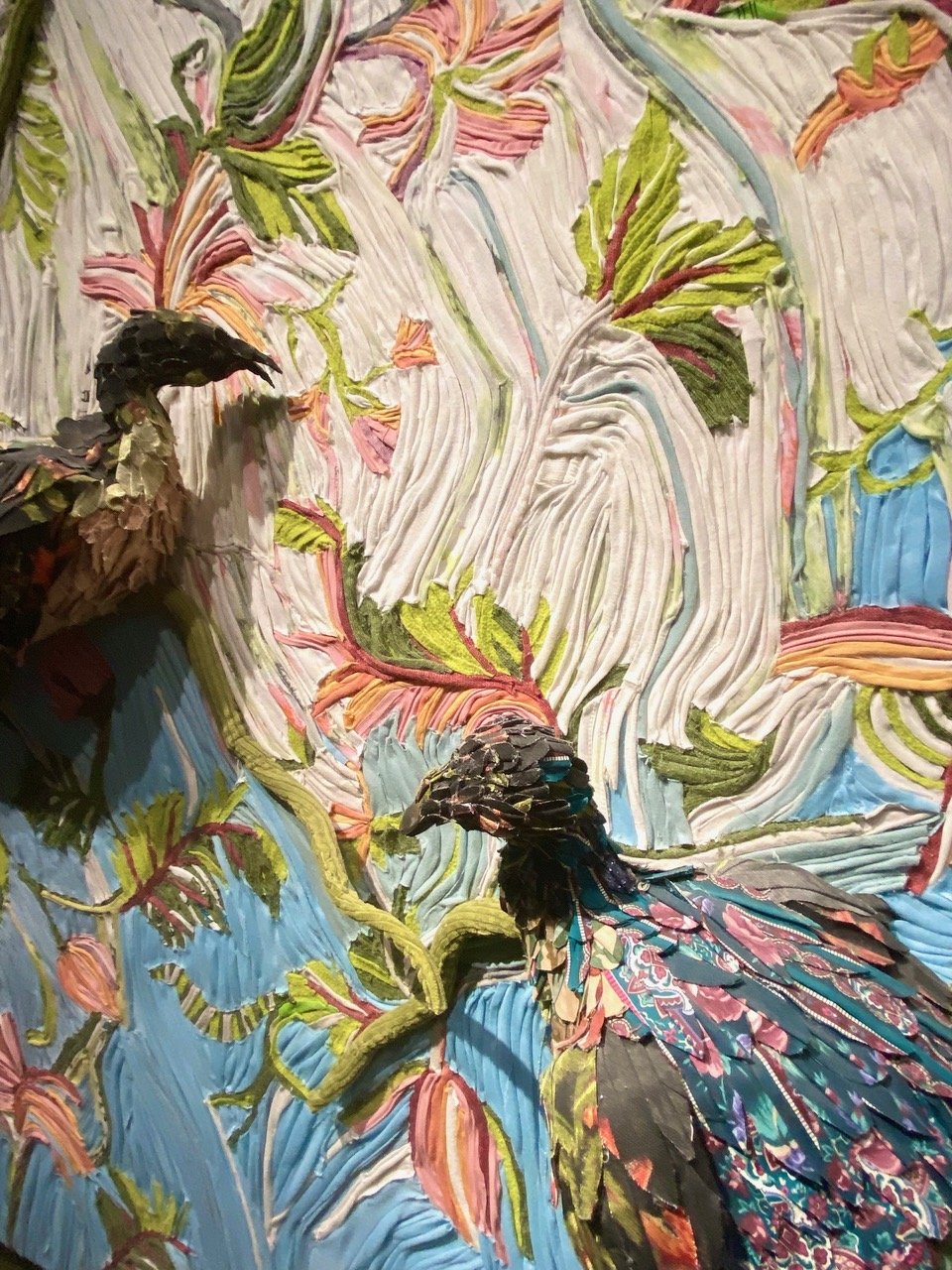One stitch at a time
Journées Européennes du Patrimoine 2024
Me outside of Le19 M, wearing my pink JEP button
Bienvenue and welcome back to Musée Musings, your idiosyncratic guide to Paris and art. Today, where I went and what I did last weekend, for the Journées Européennes du Patrimoine (JEP) held the 3rd weekend of September since 1985. The initial idea was for citizens to visit government buildings where laws are made that effect their lives but which are mostly off limits to them. Over the years, other institutions, both private and public, have begun to open their doors to the public.
I dithered around too much and by the time I tried to book the places I wanted to go on Saturday, they were booked out. So, I decided to go to the Chateau de Versailles. To see the part of the exhibition, Cheval en Majesté I had missed, in the stables (Fig 1). Then I was going to visit the Musée Lambinet, and, if I didn’t run out of time or steam, the Espace Richaud. Oh, and a patisserie and chocolatier, too.
Figure 1 Galerie des Carosses, Chateau de Versailles
The train from Paris to Versailles leaves from the Gare d’Austerlitz. There were two functioning ticket machines. Both of them with lines so long that SNCF employees were trying to speed things up by assisting people. I’m not sure it helped. After 30 minutes, I had my round trip ticket but I had missed my train. The next train was canceled and so was the train after that. I decided to give up on Versailles.
So, I went back into the metro station, got back onto the train and this time going in the opposite direction, rode all the way to the Stalingrad Station. From there, I walked to Le19M. Which was what I had planned to do on Sunday.
I first heard of Le19M last year when JR was commissioned to create a temporary facade to aesthetically hide the scaffolding covering the Palais Garnier. One element of JR’s project was the creation of a stage curtain embroidered by volunteers, trained and working with Le19M’s master embroiderers. (Fig 2)
Figure 2. JR and Opera Garnier project, 2023
About the name, the ‘Le 19’ refers to the arrondissement in which the building is located. Since CHANEL paid for the building, it also refers to Gabrielle Chanel’s birthdate. And one of her lucky numbers (another is 5). The M stands for Métiers (arts & crafts) Mode (fashion) and Main (hand), artisans who work by hand.
Le19M was welcoming the public for JEP on a show-up rather than a sign-up basis, so I wasn’t surprised that there was a long line of people waiting. As we waited, we were given pink JEP buttons and water to drink, a nice touch on a hot day.
As I approached the building, I was surprised by its size and amused by its shell.(Fig 3) As each small group entered the building, guides were there to meet us. Our first guide explained that the building opened in January 2022. Our second guide asked us to guess what else the architect of this building had designed. As soon as she told us that it was a building in Marseilles, I knew it was the architect who designed MuCEM.(Fig 4, 5) At Le19M, Algerian born French architect Rudy Ricciotti, has playfully and thoughtfully incorporated the building’s purpose onto its shell. According to the guide and my eyes, the building’s screen is woven concrete threads inspired by the warp and weft of thread on a loom.(Figs 6, 7) Of course this exoskeleton isn’t just for looks, it acts as a sun shade, too.That’s the outside, the inside is huge, five levels for 12 different ‘maisons d’art’ and their nearly 700 employees. On the ground floor there’s a bright and inviting cafe and gallery (more about that later).
Figure 3. Le19M, Entrance
Figure 4. Le19M, from the park which is open to the public
Figure 5. MuCEM, Marseilles
Figure 6. Le19M, detail
Figure 7. MuCEM, detail
For this weekend only, the public, in small groups, was invited into the Lesage workshops. (Fig 8) Lesage rather than any of the other workshops because this year Lesage celebrates its 100 birthday. Obviously a place filled with artisans wasn’t going to be giving industrial tours. Craftspeople at their work stations described their crafts. (Figs 9 -11) At one station, a man explained how the design goes from paper to fabric. It’s ‘Prick and Pounce.’ A design is drawn on a piece of paper. Then the design is traced onto tracing paper. Then, using a little rotary wheel (like a pizza wheel), holes following the pattern are pricked onto the tracing paper. The tracing paper is then placed onto the fabric and chalk is ‘pounced’ onto the tracing paper. The chalk goes through the holes in the tracing paper and onto the fabric. (Figs 12, 13) The pattern is then ready for the embroiderer. It reminded me of the seams and darts and pleats I traced onto the fabric for the dresses and skirts and jumpers I sewed in my bedroom when I was in high school. Before college, before roommates. BTW, his explanation was nearly identical to my own when I taught college students about how fresco designs get onto plaster walls for artists to paint. (Fig 14)
Figure 8. Queen Camilla visiting Maison Lesage on a state visit, 2023
Figure 9. Artisan embroidering birds, Maison Lesage
Figure 10. Artisan weaving tweeds, Maison Lesage
Figure 11. Artisan stitching in reverse, Maison Lesage
Figure 12. Pattern on paper ready to be transferred to tracing paper
Figure 13. Tracing paper over design ready to be pricked.
Figure 14. Cartoon (drawing on tracing paper) of Raphael’s School of Athens, in preparation for painting the fresco in Vatican
I didn’t really know anything about Lesage before Saturday. Here’s the abbreviated story. In 1924, Albert and Marie-Louise Lesage bought Michonet, one of the most important embroidery workshop in France. (founded in 1858) which supplied embroidery to “the greatest names in the history of Haute Couture,” among them Charles Frederick Worth and Madeleine Vionnet. Marie Louise, before she married Albert Lesage, was Vionnet’s embroidery assistant. So she knew her stuff. In the early 1930s, the Lesages began working with Elsa Schiaparelli, who ordered embroideries inspired by the circus, astrological signs, sea creatures, etc. (Figs 15-16) She worked exclusively with Lesage until she closed her shop in 1954.
Figure 15. Drawing of Elsa Schiaparelli top
Figure 16. Embroidered horse panel from Elsa Schiaparelli top
When Albert & Marie-Louise’s son François was 19, he went off to Hollywood where he was welcomed by the French expatriate community. François ‘pitched’ Lesage embroideries to costume designers and to dress designers, too. Lesage embroidered gowns for Hollywood stars like Marlene Dietrich and Lana Turner.
When his father died, François returned to France (1949) and continued working with the designers of haute couture, Balmain, Givenchy, Dior. Yves Saint. Laurent met Francois Lesage in 1963. For the next 44 years, he worked exclusively with Lesage Their most famous collaborations were the jackets inspired by Vincent Van Gogh’s Irises and Sunflowers. (Figs 17-20) The Iris jacket has 250,000 sequins in 22 colors, 200,000 beads and 250 meters of ribbon. Each jacket took 600 hours of work.
Figure 17. Jacket designed by Yves Saint Laurent and embroidered by Maison Lesage
Figure 18. Cape designed by Yves Saint Laurent and embroidered by Maison Lesage
Figure 19. Jacket designed by Yves Saint Laurent and embroidered by Maison Lesage with detail
Figure 20. Jacket designed by Yves Saint Laurent and embroidered by Maison Lesage
In 1983 Lesage began working with the creative director of Chanel, Karl Lagerfeld,. For Chanel’s ready-to-wear division, Lesage created tweeds. Since 2008, Lesage has been designing tweeds for Chanel’s haute couture collections. (Figs 21- 23)
Figure 21. Chanel tweed suits by Karl Lagerfeld embroidered by Maison Lesage
Figure 22. Chanel by Karl Lagerfeld, embroidered by Maison Lesage
Figure 23. Chanel by Karl Lagerfeld, embroidered by Maison Lesage, Detail (top left)
After we toured the workshop, we went, still in small groups, to the gallery for an exhibition celebrating Maison Lesage. It was impressive on so many levels, the dress designers with whom they work and the forays into other art forms that they have taken. (Figs 24 - 26) There was a video called Mumuration, in collaboration with the artist Aristide. It shows “hundreds of starlings embroidered by thousands of hands (artisans) on several layers of organza,” it is like watching the birds themselves “performing their perfectly synchronized ballets in the sky as they migrate from one continent to another.” (Figs 27, 28)
Figure 24. Dress designed by Jacquemus, embroidered by Maison Lesage
Figure 25. Maison Lesage working with contemporary fashion designers
Figure 26. Interior design, Maison Lesage, leaf patterns after Matisse
Figure 27. Murmuration, Maison Lesage in collaboration with artist Aristide, video
Figure 28. Murmuration, Maison Lesage in collaboration with artist Aristide, video
That was Saturday. Sunday’s weather forecast was ominous so I didn’t think that trying my luck again at Versailles was a good idea. Instead, I went to a museum that I have walked by, at least once a week, for the past four years. And that I NEVER walked into. I think the name will explain why, I mean why not. It is the Musée de la Chasse et de la Nature. (Fig 29) I am not interested in hunting. And you will find me admiring nature only if a chateau is nearby. I need a lot of culture with my nature.
Figure 29. Musée de la Chasse et de la Nature
A couple years ago, Eva Jospin, whose work I saw Versailles last month, had an exhibition here. (Fig 30) But an exhibition here wasn’t enough to get me into a museum a few blocks from my apartment. What I appreciate in Jospin’s work is her use of simple materials, cardboard mostly, and ostensibly ‘feminine’ skills, crocheting and knitting, to create delicate, massive pieces.
Figure 30. Eva Jospin design, donated by artist, Musée de la Chasse et de la Nature
The temporary exhibition at the museum now is the work of a Philadelphia based, Israeli born artist from Buenos Aires,Tamara Kostianovsky. (Fig 31) Like Jospin, Kostianovsky uses domestic materials, in her case, discarded clothes and ‘feminine' skills, mostly stitching, to create beautiful but disturbing soft sculptures. (Figs 32,33)
Figure 31. La Char du Monde, Tamara Kostianovsky, Musée de la Chasse et de la Nature
Figure 32. Tree Stump, Tamara Kostianovsky, stitched fabric
Figure 33. Detail of tree stump, stitched fabric
Biography often informs an artist’s work and that is definitely the case with Kostianovsky, whose father was a cosmetic surgeon. She explains the influence of his work on hers this way, “There was a very early link between the colors and textures of what lies beneath the skin and my introduction to the arts. The red in my painting class wasn’t just red: it was the color of blood. Yellow was not the color of the sun, but the color of the fat that filled the bags under the eyes of an elderly woman on my father’s operating table. I was fascinated by what goes on under the skin ..”
How Kostianovsky came to choose fabric as her medium is whimsical. One day, she took her clothes to a laundromat. When she pulled them out of the dryer, they had all shrunk. When my clothes shrink in the dryer, I give them to Goodwill, Kostianovsky makes hers into art!
The title of her exhibition,“La chair du monde," (Flesh of the world), is a reference to the philosopher, Maurice Merleau-Ponty (Phénoménologie de la perception, 1945) who wrote that perception is not merely a cerebral activity, that our relationship to the world is physical, too. Perception goes beyond the senses and the brain, to the body and the body’s interaction with the environment. Art is visceral.
The 30 works in this exhibition are scattered throughout the museum. It begins on the ground floor temporary exhibition space. A massive, chopped off tree trunk, made out of rolled and stitched fabric is our introduction to Kostianovsky who has explained her fascination with decaying tree trunks this way, “On a hike, I discovered a fallen tree trunk that was completely covered with rich green moss that transformed the trunk into a spectacular throne.Since then, I’ve been researching dead trees and how they can become hosts to new life.” (Fig 34)
Figure 34. Another Tree Stump, Tamara Kostianovsky, stitched fabric
Even the decaying tree trunk didn’t prepare me for the sides of beef hanging by rope on hooks in another room. According to the artist: “The(y) represents carcasses that transform into vegetation, becoming capsules that house birds and exotic plants. I conceive of these works in terms of metamorphosis. The idea is to transform the image of the carcass, which, from a place of carnage, becomes a matrix where life takes root – in the manner of a utopian environment….” (Figs 35, 36)
Figure 35. Two Hanging Carcasses, Tamara Kostianovsky, stitched fabric
Figure 36. Hanging Carcass, Tamara Kostianovsky, stitched fabric
Soft sculptures of tropical birds, with their exotic, colorful plumes perch on plush purple velvet wallpaper in a room filled with paintings by Chardin and Desportes. The wallpaper, French from the Age of Enlightenment is a reference to 18th century Europe’s imagination of the exotic ‘other,’ a world filled with magical flora and fauna and people, too.(Figs 37-40)
Figure 37. Triptych Exotic Birds, Tamara Kostianovsky, stitched fabric
Figure 38. Triptyph Exotic Birds, detail, Tamara Kostianovsky, stitched fabric
Figure 39. Exotic Bird against wallpaper, Tamara Kostianovsky, stitched fabric
Figure 40. Exotic Bird, Tamara Kostianovsky, stitched fabric
Everything about this museum was a happy surprise. Gifts from other artists (including Jospin) who have held exhibitions here, are scattered throughout the museum. (Figs 41-44) There was a video of a bird cage filled with small birds. The cage was open but very few of the birds flew out. I stood and watched it with a man who told me that he would be retiring in 6 weeks and he was feeling like those birds, freedom was close but he wasn’t sure he would like it. We then read the wall text, the video was by an Iranian artist, which added another, more poignant layer to the work.
Figure 41. Fox curled up on a chair
Figure 42. House of books made of wings. Books arranged by color (as they are in my own home!)
Figure 43. Self portrait of an artist in the museum with a duck
Figure 44. A case filled with tins of exotic animals as food, flower painting above
The rooms filled with mounted heads (Fig 45) and stacks of guns had explanatory texts (in French and English) that made them less offensive to me somehow. All museums in the city were asked to reference the Olympics this year. This museum did so with a tongue-in-cheek sense of humor.(Figs 46, 47)
Figure 45. Room of Trophy Heads with an interesting ceiling
Figure 46. Throughout the museum, funny little references to the Olympics
Figure 47. An unsuccessful jumper at the base of the steps
As I walked home from the Musée de la Chasse et de la Nature, I thought about how my JEP weekend had a common thread (pun intended) running through it - fabric and crafts(wo)manship. Gros bisous ‘Dr. B
Comments for which I am very grateful. thank you!
New comment on Relishing Relics:
Dear Dr.B. Thank you for the wonderful discussion of relics which should be included in every introduction to religion course which is offered at many colleges as an elective. The course I took did not include this so my first visit to Notre Dame was an eye opener. I love the Cluny and it is a quiet and peaceful place that is, at times, under the radar of wonderful sites I think. The tapestries are particularly striking and the objects dredged from the Seine that were discarded hundreds of years ago are most interesting. Medieval old comb thrown out or lost...today's treasure ..which makes you connect with someone unknowingly. I am glad to see there is a place to sit and have something to eat there now! Sincerely, Dianne
